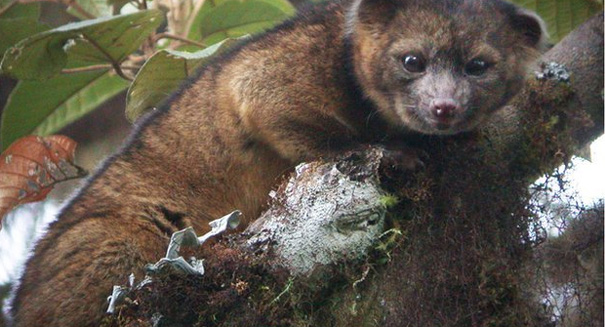
A new mammal is discovered.
A new species has been discovered in the cloud forests of Ecuador and Columbia, the first carnivore to be found in the western hemisphere in the last 35 years. More than just a cute find, the olinguito’s discovery signifies that sometimes a new species could be hidden in plain sight and that humans are still a ways off from knowing every animal in the world.
“The age of discovery is not over,” said study leader Kristofer Helgen, curator of mammals at the Smithsonian’s National Museum of Natural History. “In 2013 we have found this spectacular, beautiful animal, and there’s a lot more to come.” At merely two pounds, the large-eyed mammal is a solitary creature that comes out only at night. It is the smallest known member of the raccoon family and is part of the taxonomic order Carnivora even though it eats mostly plants. Finding a new mammal is uncommon enough; discovering a carnivore—far scarcer in nature than herbivores—is “incredibly rare” according to the study.
Helgen’s discovery came from nearly a decade of sleuthing. In 2003, he was at the Field Museum in Chicago studying specimens of olingos, a related group of South American carnivores, and noticed that some of the specimens had smaller teeth and longer coats than others. Upon further research, Helgen discovered reddish pelts—far different from the olingos’ gray coat—and notes explaining they were from decades earlier in the Andes at between 5,000 and 9,000 feet in elevation, much higher than olingos’ general habitat range.
After these museum findings, Helgen realized he may have found a new species and decided to search for it. In 2006, Helgen joined forces with Roland Kays, director of the Biodiversity and Earth Observation Lab at the North Carolina Museum of Natural Sciences and Ecuadorian zoologist Miguel Pinto. They agreed to begin their pursuit in western Ecuador’s Otanga Cloud Forest Preserve and found the olinguito the first night.
Though the olinguito was discovered this year, it has actually been near us a long time. Locals have been living among olinguitos in the forests, and specimens have been displayed in museums, though as olingos, for over a hundred years, Helgen noted. In fact, one olinguito lived in US zoos in the 1960s and 1970s, misidentified as an olingo.
The olinguito is a cute reminder that Earth still hides many treasures. “If you feel like the world has been picked over, you have the wrong idea,” Helgen said. “If the olinguito can hide out until 2013, just think about how much else is hiding out there.” Or hanging out in the open just waiting for humans to notice.
Leave a Reply